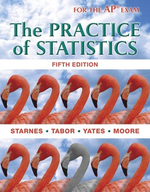Solution Found!
Two-Sample T-Test: Analyzing Control vs. Supplemented Groups
Chapter 10, Problem 41(choose chapter or problem)
Do birds learn to time their breeding? Blue titmice eat caterpillars. The birds would like lots of caterpillars around when they have young to feed, but they must breed much earlier. Do the birds learn from one year’s experience when to time their breeding next year? Researchers randomly assigned 7 pairs of birds to have the natural caterpillar supply supplemented while feeding their young and another 6 pairs to serve as a control group relying on natural food supply. The next year, they measured how many days after the caterpillar peak the birds produced their nestlings. The investigators expected the control group to adjust their breeding date the next year, whereas the well-fed supplemented group had no reason to change. Here are the data (days after caterpillar peak):
\(\begin{array}{lrrrrrrr} \hline \text { Control: } & 4.6 & 2.3 & 7.7 & 6.0 & 4.6 & -1.2 & \\ \text { Supplemented: } & 15.5 & 11.3 & 5.4 & 16.5 & 11.3 & 11.4 & 7.7 \\ \hline \end{array}\)
(a) Do the data provide convincing evidence to confirm the researchers’ belief?
(b) Interpret the P-value from part (a) in the context of this study.
Questions & Answers
QUESTION:
Do birds learn to time their breeding? Blue titmice eat caterpillars. The birds would like lots of caterpillars around when they have young to feed, but they must breed much earlier. Do the birds learn from one year’s experience when to time their breeding next year? Researchers randomly assigned 7 pairs of birds to have the natural caterpillar supply supplemented while feeding their young and another 6 pairs to serve as a control group relying on natural food supply. The next year, they measured how many days after the caterpillar peak the birds produced their nestlings. The investigators expected the control group to adjust their breeding date the next year, whereas the well-fed supplemented group had no reason to change. Here are the data (days after caterpillar peak):
\(\begin{array}{lrrrrrrr} \hline \text { Control: } & 4.6 & 2.3 & 7.7 & 6.0 & 4.6 & -1.2 & \\ \text { Supplemented: } & 15.5 & 11.3 & 5.4 & 16.5 & 11.3 & 11.4 & 7.7 \\ \hline \end{array}\)
(a) Do the data provide convincing evidence to confirm the researchers’ belief?
(b) Interpret the P-value from part (a) in the context of this study.
ANSWER:Step 1 of 6
Given:
\(\begin{array}{l} n_{1}=\text { Sample size }=6 \\ n_{2}=\text { Sample size }=7 \\ \alpha=\text { Significance level }=5 \%=0.05 \end{array}\)
Check conditions
The conditions to use the two-sample t-test are: Random, 10% and Normal/Large sample.
Random: Satisfied, because the pairs of birds were randomly assigned to a group.
10% : Satisfied, because the 7 pairs of birds are less than 10% of all pairs of birds and the 6 pairs of birds are less than 10% of all pairs of birds.
Normal/Large sample: Satisfied, because the pattern in the normal probability plot of each sample (given below) does not contain strong curvature and thus both samples appear to come from a population with approximately a normal distribution.
Thus we note that all conditions are satisfied.
Watch The Answer!
Two-Sample T-Test: Analyzing Control vs. Supplemented Groups
Want To Learn More? To watch the entire video and ALL of the videos in the series:
Explore the steps to conduct a two-sample t-test using a control and supplemented group. Through hypothesis testing, standard deviation, and P-value interpretation, we analyze the means of both groups to determine statistical differences.
